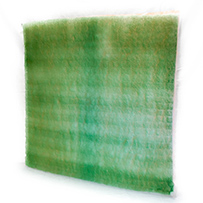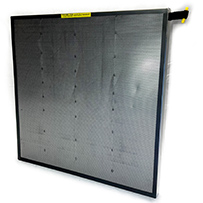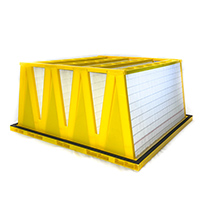Filters
ORDER FiltersFour Stage Filter System
Each of the four (4) stage OEM filters is specifically deigned and engineered for maximum filtration while allowing maximum airflow over a greater velocity range i.e. from 2,200 cfm to 3,900 cfm enabling capture of harmful airborne particulates as small as 3 microns, including toxic fumes and vapours associated with body shop environments.
- Stage 1 - 2" Green Pre-Filter Pad
- Stage 2 - 3" HP90 1 Micron Filter
- Stage 3 - CF2R Activated Carbon Filter
- Stage 4 - AC24 Activated Carbon Top Filter

-
Stage 1 - 2" Green Pre-Filter Pad

D3000
DowndraftD3000
Fume ControlD3000
StandardDimensions:
23-1/2" x 23-1/2" x 2"
597mm x 597mm x 50mmDescription:
- High capacity media captures visible dust, spray powder, and paint
- Used in front of intake filter
- Cleanable
Part Number: 11703
-
Stage 2 - 3" HP90 1 Micron Filter (includes 11703)

D3000
Fume ControlD3000
StandardDimensions:
23-1/2″ x 23-1/2″ x 3″
597mm x 597mm x 76mmDescription:
- Metal framed intake filter with surface loading media, pleated for greater surface area capture
- Filters particulates down to 1 micron
- Cleanable
Part Number: 11204
-
Stage 3 - CF2R Activated Carbon Filter

D3000
Fume ControlD3000
StandardDimensions:
23-1/2" x 23-1/2" x 1.5"
597mm x 597mm x 37mmDescription:
- Metal framed carbon filter contains activated carbon pellets (15lbs per filter)
- Removes VOCs, Isocyanates, toxic fumes and odours
- Not cleanable
Part Number: 11406
-
Stage 4 - AC24 Activated Carbon Top Filter

D3000
Fume ControlDimensions:
23-1/2″ x 23-1/2″ x 11-1/2″
597mm x 597mm x 290mmDescription:
- Contains 24lbs activated granular carbon for high fume environments
- Removes VOCs, Isocyanates, toxic fumes and odours
- Not cleanable
Part Number: 11401
-
Stage 4 - MP85 0.3 Micron Top Filter

D3000
StandardDimensions:
23-1/2″ x 23-1/2″ x 11-1/2″
597mm x 597mm x 290mmDescription:
- High efficiency media top filter for micro particles
- Captures invisible dust down to 0.3 micron
- Not cleanable
Part Number: 11602
How it works
-
1
Positive airflow discharged from the top of machine creates a negative pressure “capture” zone at base of unit
-
2
Contaminated air is drawn in through the three intake openings at floor level
-
3
Contaminated air is filtered through four stages of filtration and cleaned down to 1 micron (or 0.3 micron if using the optional MP-85 Micro Filter)
-
4
Mushroom airflow pattern created will effectively clean up to 5,000 sq ft floor area
-
5
Clean air is continuously re-circulated at over 3,000 cubic feet per minute

1
2
3
4
5
Specifications
Dimensions
| Width (in/mm) |
Height (in/mm) |
Depth (in/mm) |
|---|---|---|
| 34 / 864 | 72 / 1830 | 29 / 737 |
| Weight (lbs/kg) |
Foot Print (sq ft/m2) |
Overall Length (in/mm) |
|---|---|---|
| 181 / 84 | 6.5 / 0.6 | N/A |
| Construction: | Unit body, double zinc coated sheet metal, gray powder coat finish |
|---|---|
| Casters: | Heavy duty urethane swivel wheels |
| Electric Motor: | 1-1/3 HP, 110Vac, 12 amps, 1 Ph explosion proof,thermally protected Electrical: CSA HazLoc certification to Class 1, Div. II, Group D and Class II, Div. II, Group F and G Sealed components for Hazardous Location (Hazloc) operation Two (2) light safety operating system |
| Options: | CE Electrical setup for 220 Vac |
Particulate Removal
Common airborne pollutants vary in size, from invisible (under 18 microns) to visible. This chart shows the relative size and the method of removing them from the air, using either particulate removal filters or activated carbon filters.

What is Carbon Capacity?
The capacity index chart lists substances by both chemical and common name. It is a general list of the most common compounds found in the workplace. The efficiency and capacity of activated carbon to adsorb these substances varies with the concentration in the air, relative humidity and temperature. The capacity index numbers are representative under average conditions and may vary under local conditions.
Carbon Capacity Index
Activated carbon adsorbs gas phase pollutants including VOCs and Isocyanates. The ability of adsorption is set out below.
CARBON CAPACITY REFERENCE CHART
For standard activated carbon four index capacity values are defined as follows
4 = High Capacity
Substances are adsorbed very efficiently. One pound of activated carbon adsorbs about 20% to 50% of its own weight – average about 1/3 (33-1/3%). This category includes most of the odor causing substances.
3 = Satisfactory
Substances are adsorbed well, but not as efficiently as substances rated 4. One pound of activated carbon adsorbs about 10 to 25% of its weight – average about 1/6 (16.7%).
2 = Borderline
Substances are not highly absorbed but might be adsorbed sufficiently to give acceptable results under the particular operating conditions. These require individual checking.
1 = Poor
Substances that are not adsorbed by activated carbon fall into this category.
TYPICAL HARMFUL AIRBORNE SUBSTANCES & CHEMICALS INDICATING ACTIVATED CARBON CAPACITY RATINGS
| Acetone | 3 - Satisfactory |
|---|---|
| Benzenes | 4 - High Capacity |
| Butyl Acetate | 4 - High Capacity |
| Chlorobenzene | 4 - High Capacity |
| Chloroform | 4 - High Capacity |
| Ethyl Benzene | 4 - High Capacity |
| Gasoline | 4 - High Capacity |
| Hexane | 3 - Satisfactory |
| Hexamethylene | 3 - Satisfactory |
| Methylene Chloride | 3 - Satisfactory |
| Methyl Ethyl Ketone | 4 - High Capacity |
| Naphtha | 4 - High Capacity |
|---|---|
| Nitro Benzenes | 4 - High Capacity |
| Ozone | 4 - High Capacity |
| Paint Fumes | 4 - High Capacity |
| Perchioroethylene | 4 - High Capacity |
| Pyridine | 4 - High Capacity |
| Smoke | 4 - High Capacity |
| Solvents | 3 - Satisfactory |
| Styrene Monomer | 4 - High Capacity |
| Toluene | 4 - High Capacity |
| Xylenes | 4 - High Capacity |


